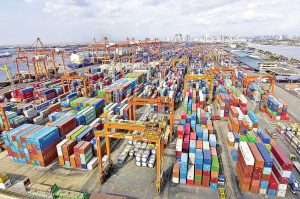
PHL posts $4.6-B trade deficit in May
THE PHILIPPINES’ trade gap widened slightly in May, as exports and imports contracted on an annual basis, the statistics agency said on Wednesday.
Preliminary data from the Philippine Statistics Authority (PSA) showed that the country’s trade-in-goods balance — the difference between exports and imports — stood at a $4.601-billion deficit in May, slightly wider than the $4.4-billion gap a year ago.
However, the May trade gap narrowed from the $4.73-billion deficit in April.
“The modest narrowing of the trade deficit was exactly in line with our expectations and was driven primarily by an unwinding of adverse export and import seasonal effects,” Pantheon Macroeconomics Chief Emerging Asia Economist Miguel Chanco said in an e-mailed note.
For the January-to-May period, the trade deficit shrank by 13.08% to $20.59 billion from the $23.69-billion gap a year ago.
The country’s balance of trade in goods has been in the red for 108 straight months (nine years) or since the $64.95-million surplus in May 2015.
PSA data showed the value of exports declined by 3.1% to $6.33 billion in May from $6.53 billion in the same month a year ago. Month on month, exports inched up by 0.6% from $6.29 billion in April.
Despite the drop, May saw the highest export value in seven months or since $6.52 billion in October 2023.
Year to date, exports grew by an annual 7.81% to $30.84 billion.
Rizal Commercial Banking Corp. Chief Economist Michael L. Ricafort said exports benefited from the weaker peso against the US dollar in May.
In mid-May, the peso sank to the P58-per-dollar level for the first time in 18 months or since November 2022. The peso closed at P58.52 against the dollar as of end-May, depreciating by P0.94 from its P57.58 finish as of end-April.
Meanwhile, PSA data showed imports dipped by 0.03% to $10.929 billion in May from $10.93 billion a year ago, and by 0.8% from $11.02 billion in April.
For the first five months, imports fell by 1.66% to $51.43 billion.
“Imports were flat in year-on-year terms, and down only slightly in US dollars from April, resulting in a less favorable deficit than we had been hoping to see. However, the net result of no change in the deficit was in line with expectations and should have no substantial or lasting consequences for the Philippine peso,” Robert Carnell, regional head of research, Asia-Pacific at ING Economics, said in an e-mail.
The Development Budget Coordination Committee projects 5% and 2% growth in exports and imports, respectively, this year.
ELECTRONIC EXPORTS DECLINE
Manufactured products, which made up 80.3% of total exports, fell 3.5% to $5.08 billion in May from $5.27 billion last year, PSA said.
Exports of electronic goods, which accounted for more than half of manufactured products, declined by 5.1% to $3.56 billion in May from $3.75 billion a year ago. Semiconductor exports dropped by 13.3% to $2.75 billion in May.
“By major component, electronic exports, which make up the lion’s share of the Philippine export basket, were fractionally lower than the previous month, but nothing to be alarmed by. There were also some better figures for manufactured exports,” Mr. Carnell said.
Exports of mineral products, which accounted for 10% of total exports, declined by 8.4% to $633.63 million in May.
The United States was once again the top destination for Philippine-made goods, with exports valued at $1.08 billion or 17% of the total exports in May.
Hong Kong, which was the top exports destination in April, fell to second spot with exports valued at $904.79 million or 14.3% of the total in May. This was followed by Japan ($882.7 million or 13.9%) and China ($847.12 million or 13.4%).
“By country, exports to Mainland China remain weak, falling by 9.1% year on year, but imports to Hong Kong are holding up much better and these are probably destined for Mainland China too,” Mr. Carnell said.
Mr. Chanco noted that shipments to other markets were stable, if not up slightly month on month.
“Overall export momentum has ebbed in recent months, but the sturdy year on year performance of exports in Korea — a bigger player in semiconductors — suggests that Philippine export growth should bounce in the short run,” he said.
Philippine exports to South Korea stood at $265.23 million in May.
Meanwhile, PSA data showed imports of raw materials and intermediate goods, which accounted for 37% of the total imports, inched up by 0.6% to $4.09 billion in May.
Imports of capital goods, which had a share of 25.6%, fell by 11.5% to $2.8 billion, while imported consumer goods edged up by 0.4% to $2.14 billion.
In terms of import value, the top three commodity groups were electronic products ($2.15 billion); mineral fuels, lubricants and related materials ($1.85 billion); and transport equipment ($891.7 million).
In May, China was the main source of imported goods, which were valued at $2.73 billion or 25% of total imports.
This was followed by South Korea ($989.6 million or 9.1% of the total), Indonesia ($972.15 million or 8.9%), and the United States ($748.19 million or 6.8%). — Beatriz Marie D. Cruz



